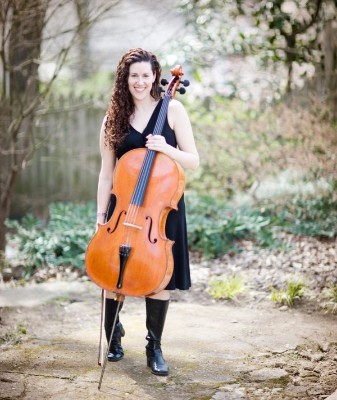As the end of the fall semester approaches, the Swarthmore College Orchestra is preparing for its fall concert, featuring renowned cellist Amy Barston. Barston is one of the Department of Music and Dance’s Featured Artists for the 2018-19 year.
Barston is an incredible musician who has played as a soloist with a number of prestigious orchestras, including a performance with the Chicago Symphony Orchestra at the age of seventeen. She’s also a Juilliard graduate and a cello teacher for the Juilliard Pre-College program, and held a master class for musicians at Swarthmore earlier this month.
The Swarthmore College Orchestra will be playing the Dvorak Cello Concerto with Barston. “When Amy Barston agreed to be one of our Featured Artists this season, we started to talk about what concerto she might play with the orchestra,” recounts orchestra director Andrew Hauze ‘04. “The Dvorak was at the top of both of our lists: not only is it an exquisitely beautiful piece, but it is really symphonic in conception, with a breadth and variety in the instrumental writing that shows Dvorak at his most orchestrally inventive.”
Dvorak was noted to have been originally reluctant to write a concerto for cello, arguing that the cello’s range was utterly unsuited for solo playing with orchestral accompaniment. However, it is now hailed as perhaps one of the greatest concertos of all time, full of beautiful melodic interplay and compelling themes.
Hauze explained his thought process for why he found the Dvorak particularly well-suited for the Swarthmore College Orchestra.
“In an academic setting it’s always best if we can find concerti that will be fulfilling for the orchestra to rehearse alone (without the soloist) for most of the semester, and, in my opinion, the Dvorak has one of the most interesting orchestral parts of any concerto in the standard repertoire. The first movement is on a grand and dramatic scale; the second movement is almost like a wind serenade, filled with prayers, laments, tender beauty, and a funeral march; and the last movement seems to evoke Dvorak’s Slavonic Dances, eventually melting into a ‘long goodbye’ when Dvorak lands in B Major and seems to just want to linger, finding new and ever more beautiful ways to reaffirm our ‘home’ key.”
The other feature for the fall concert is Schumann’s Symphony no. 3. However, this was not the original plan for the fall semester.
“For most of the summer I had planned to pair the Franck D Minor Symphony with the Dvorak concerto,” said Hauze. “I was all set to program it until we had some changes in our personnel: fewer low brass players and not quite as many woodwinds, but lots of new string players! The Franck was no longer as good a fit for our instrumental makeup, and so I decided just before our first rehearsal to substitute Schumann’s Third Symphony.”
Schumann’s Third is a personal favorite of his. “It has magnificent passages for each section of the orchestra. It is also a tremendously life affirming piece and, despite being at times very tiring for the orchestra (as Schumann loves for lots of people to be playing at once), its extraordinary energy and variety of moods make it a deeply satisfying musical experience for player and listener alike. I particularly love the solemn and somewhat creepy fourth movement (a memory of a religious procession outside the majestic Köln Cathedral) that is answered by a jolly and bubbling Finale.”
The Swarthmore College Orchestra’s fall concert is December 1st, at 8:00 pm in Lang Concert Hall.
Andy Zhang ’22
